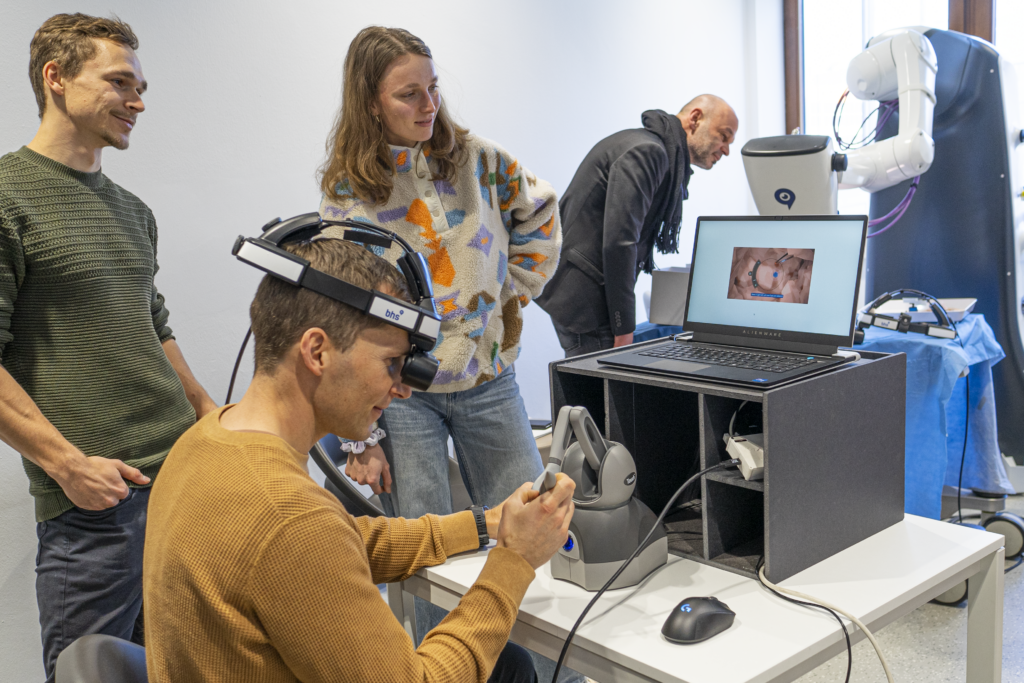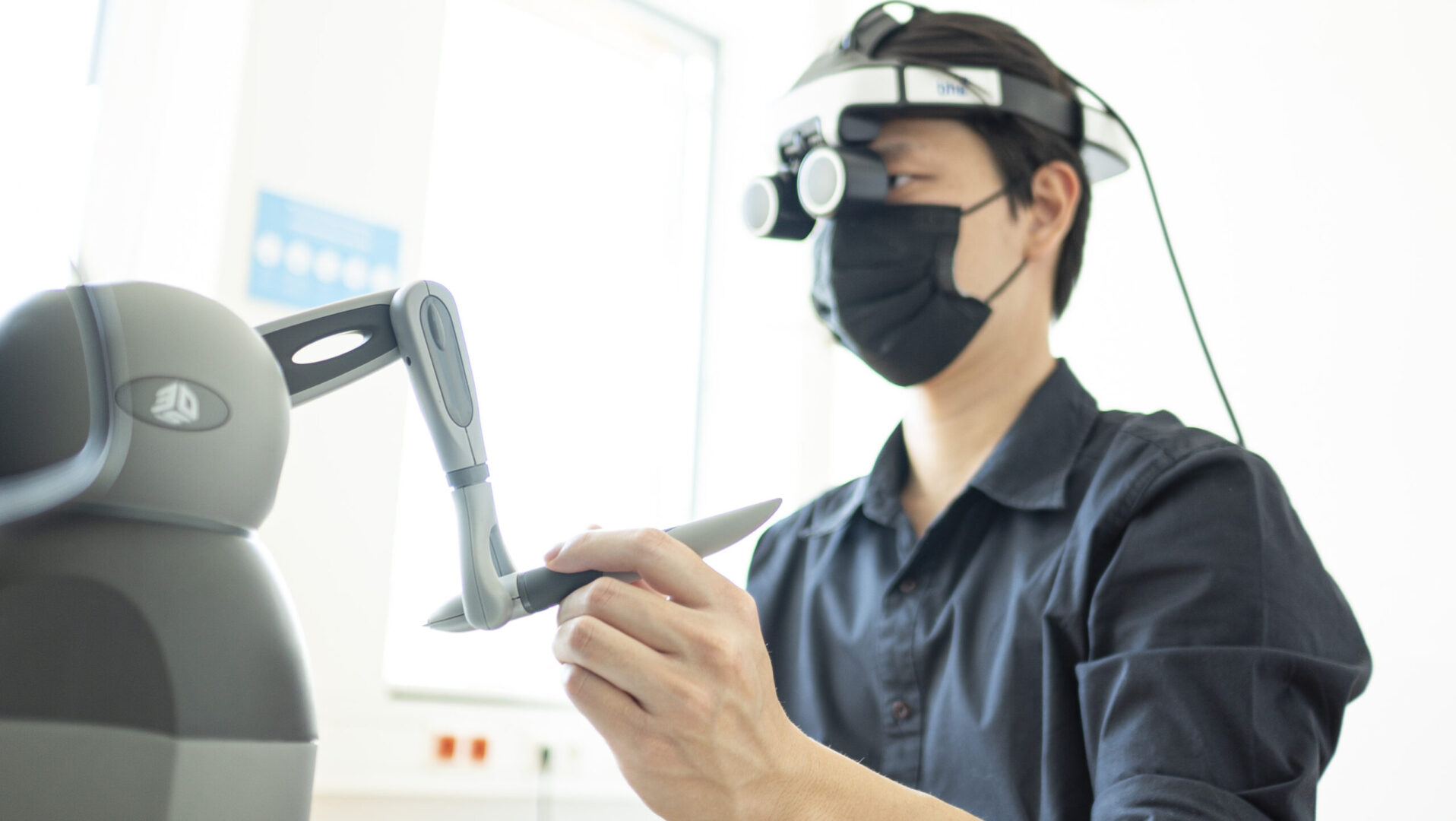Back in 2017 BHS Technologies started with the world’s first RoboticScope, a Head Gesture-Controlled 3D robotic microscope, to give microsurgeons an instrument that expands their senses and enables surgeons to operate in their best ergonomic position, creating a flexible working environment for them.
During the development process, HYVE’s designers gained extensive experience through intensive technology scouting with regard to technical requirements and implementation options as well as usability and use in various operations, for example in the field of ENT, plastic, and neurological surgery. This experience and the at the time development status and a great deal of further research formed the basis for the targeted development of the industrial design as well as the conception and implementation of a user interface/human user interface/human-machine interface suitable for surgeons.
BHS Technologies robotic microscope series development – Collaboratively Advancing Surgical Digitalization
As the field of surgery continues to embrace digitalization, the question arises: What is the next step in revolutionizing this critical domain? The answer lies in a solution that is simple, agile, and effective, addressing the evolving needs of surgeons and patients alike.
In tackling this challenge, HYVE supported BHS Technologies throughout the journey. We started with a UX Workshop all around the Head-Mounted Display. From the initial stages, where the design vision was conceptualized, to the subsequent proof of concept, HYVE’s expertise paved the way for BHS Technologies to develop cutting-edge technology.
The outcome is a transformative leap in surgical digitalization, where precision meets practicality.

BHS Technologies head-mounted display – Crafting Intuitive Excellence
Defining the ideal characteristics of a head-mounted display in the medical field poses a unique set of questions. What should it look like, and how can it be intuitively utilized to enhance medical practices?
Addressing these challenges requires a holistic and collaborative effort. Enter a long-term design cooperation involving the collective expertise of engineers, product management, and surgeons. This multidisciplinary approach ensures that the head-mounted display not only meets technical requirements but also aligns seamlessly with the intuitive needs of medical professionals.
The primary control interface of the RoboticScope is the Head-Mounted Display (HMD). Positioned directly in front of the surgeon’s eyes, the HMD incorporates two digital micro displays that offer a real-time depiction of the surgical area in 3D. Serving as the central hub for managing the robot, camera, and various other core functionalities of the RoboticScope, the HMD ensures seamless control and visualization during procedures.
Distinguishing itself from traditional surgical microscopes, the RoboticScope features innovative Head Gesture Control capability. This functionality enables surgeons to manipulate all aspects of the RoboticScope through natural head movements. Whether it’s tilting, rotating, or shifting the head in different directions, surgeons can effortlessly adjust settings and functionalities with intuitive gestures. This intuitive control system empowers surgeons to navigate the user interface, oversee the RoboticScope’s operations, and dictate the direction and pace of movements with ease.
BHS Technologies digital twin for training (ongoing research project) – A Cost-Effective Simulation Approach
The current challenge revolves around enabling surgeons to train and familiarize themselves with the RoboticScope before using it in the OR. The question is how to achieve this goal while ensuring the effectiveness of the training process.
In response to this challenge, a groundbreaking solution has emerged through a collaborative, publicly funded research project with BHS Technologies. This innovative approach involves simulating robot kinematics, optics, and the user interface. A pivotal aspect of this approach is the design of a training application that leverages virtual spaces and gamification to enhance the overall training experience.
HYVE has introduced a digital twin that facilitates training, to get familiar with the RoboticScope and its User Interface, offering several advantages:
- Ease of Introduction: BHS Technologies can effortlessly introduce their product to new customers without the logistical challenges of transporting and setting up the physical robot.
- Uninterrupted Training for Doctors: Surgeons can undergo training without hindering access to the physical device.
- Early Training for Students: Students can commence their training early on
- Retraining Flexibility for Surgeons: Surgeons have the option to retrain if they encounter obstacles with the actual device.
The Digital Twin employs an authentic BHS Technologies headset for training and mimics the behavior of the actual device in the virtual environment. The training primarily focuses on controlling the robotic scope arm.

Following BHS Technologies training principles, the program incorporates both “main training” (core functions of device operation) and “secondary training” (secondary and Quality of Life functions). Serious game principles are applied to make the training enjoyable and conducive to easy memorization. The virtual environment, based on reality but highly abstracted, contributes to a playful learning experience.
HYVE leads the development of a comprehensive software package seamlessly interfacing with the original head-mounted display and a foot pedal, effectively simulating the robotic microscope experience. This software package is not a mere replication; it is a thoughtfully designed application that encompasses the entire user journey.
Every aspect, from the hardware package to level design, is meticulously crafted to provide a realistic and immersive training environment. The application goes beyond functionality by tracking training progress through various parameters. Its efficacy is validated through university studies, comparing it with training on the actual product to ensure tangible benefits. Consequently, this simulator emerges as an invaluable tool for surgical training, eliminating the need for physical robotic equipment.


